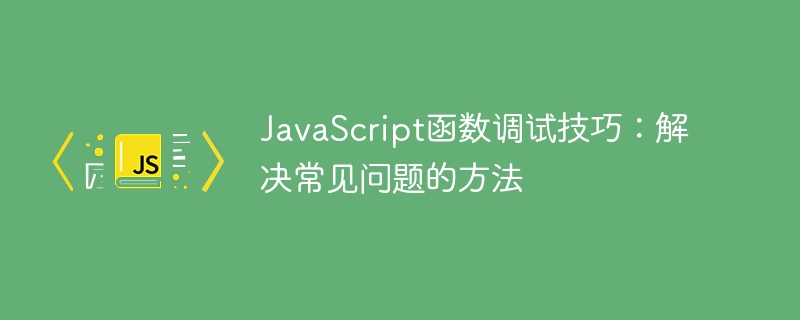

JavaScript function debugging skills: ways to solve common problems
Introduction:
As a commonly used scripting language, JavaScript is widely used in web development and mobile applications is under development. During the development process, we often encounter the problem of function debugging. This article will introduce some debugging techniques to solve common problems, and attach specific code examples to help readers better understand and apply these techniques and improve development efficiency.
1. Use console.log() to output debugging information
console.log() is one of the commonly used debugging methods in JavaScript. By adding a console.log() statement to the function, the value of the variable can be output so that we can understand how the code is running. The following is an example:
function add(a, b) { console.log("a: ", a); console.log("b: ", b); return a + b; } var result = add(2, 3); console.log("result: ", result);
In the above code, we use console.log() inside and outside the add function to output the values of parameters a and b and the return value of the function.
2. Use the debugger statement to set breakpoint debugging
In addition to console.log(), we can also use the debugger statement to set breakpoint debugging. Place the debugger statement somewhere inside the function. When execution reaches that location, the code will pause execution and enter the debugging state, allowing us to view the execution of the code line by line and monitor the values of variables. The following is an example:
function multiply(a, b) { debugger; // 设置断点 var result = a * b; return result; } var result = multiply(2, 3); console.log("result: ", result);
In the above code, we use the debugger statement inside the multiply function. When the debugger statement is executed, the code will pause execution. At this time, we can develop through the browser Use the debugging function of the tool (usually opened by pressing the F12 key) to view the execution of the code line by line and monitor the values of variables.
3. Use try...catch statement to catch exceptions
When writing functions, exceptions may occur, such as null references, type errors, etc. In order to avoid the program crashing due to exceptions, we can use try...catch statements to catch exceptions and handle error conditions. Here is an example:
function divide(a, b) { try { if (b === 0) { throw new Error("Divisor cannot be zero"); } var result = a / b; return result; } catch (error) { console.log("Error: ", error.message); } } var result = divide(6, 0); console.log("result: ", result);
In the above code, we use the try...catch statement inside the divide function. When the throw statement is executed, the code will jump to the catch block to capture and output the error information.
Conclusion:
This article introduces some common techniques for debugging JavaScript functions and gives specific code examples. Use console.log() to output debugging information, the debugger statement to set breakpoints for debugging, and the try...catch statement to capture exceptions. These skills can help us better understand and debug the code and improve development efficiency. I hope readers can master these skills and be able to flexibly apply them to actual development work.
The above is the detailed content of JavaScript function debugging tips: ways to solve common problems. For more information, please follow other related articles on the PHP Chinese website!




